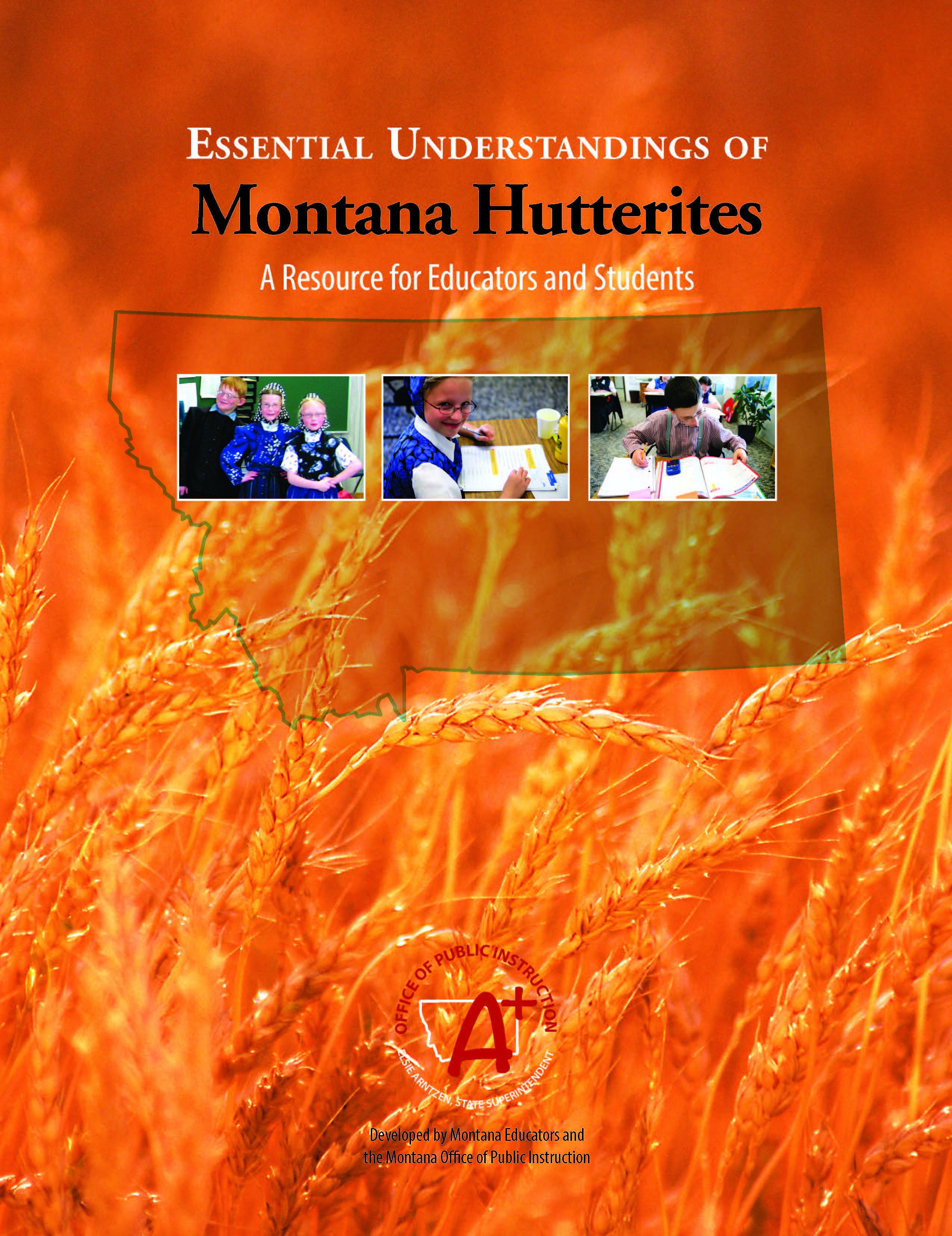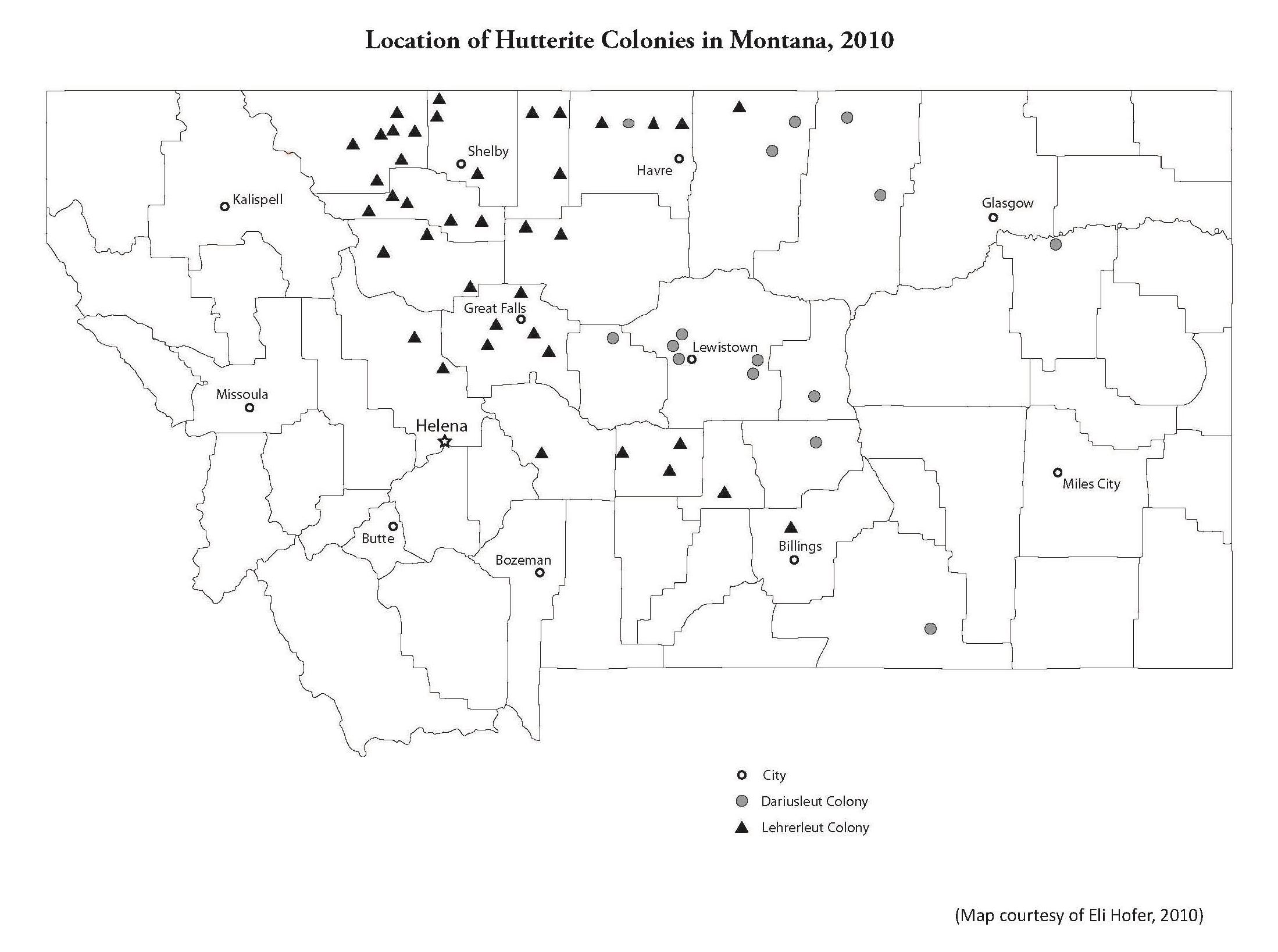Montana Educators, Montana Office of Public Instruction & Claudette Morton
Essential Understandings of Montana Hutterites
A Resource For Educators and Students

Essential Understandings of Montana Hutterites A Resource for Educators and Students
The concept for this work came from Indian Education for All: Essential Understanding Regarding Montana Indians developed by the Office of Public Instruction, revised January 2008. This document is intended to be a resource to increase understanding about Montana Hutterites.
A special thanks to David M. Hofer, Eagle Creek Colony; Sam Hofer, Springdale Colony; Joe S. Kleinsasser, Kingsbury Colony; Peter J. Waldner, East End Colony; John Waldner, Pleasant Valley Colony; William W. Kleinsasser, Milford Colony; Eli Hofer, North Harlem Colony; Paul B. Hofer, Elkwater Colony; Marsha Davis, Lewis and Clark County Superintendent of Schools; Lynn Hinch, Office of Public Instruction and the Montana Small Schools Alliance.
Title Page
Essential Understandings of Montana Hutterites:
A Resource For Educators and Students
Developed by Montana Educators and the Montana Office of Public Instruction
Researched and edited by Dr. Claudette Morton,
Published by the Montana Office of Public Instruction, 2010
Montana
Office of Public Instruction
opi.mt.gov
Elsie Arntzen, Superintendent

Essential Understandings Regarding Hutterites (Hutterite Brethren, Hutterians)
Essential Understanding 1
Hutterites Colonies exist throughout Montana. [See map on next page.]
They pay taxes and contribute to Montana’s economy.
BACKGROUND
The term Hutterite comes from the name of the founder of the group, Jakob Hutter, a hat maker by trade. Hut is German for hat and the English pronunciation of Hutterite is with a short u, the same way we pronounce the name of a small house: hut.
Hutterite people live in colonies located primarily throughout rural Montana, South Dakota and the Canadian Provinces of Alberta, Saskatchewan and Manitoba. A colony is a group of families governed by the minister who is elected. A secretary, who writes checks and keeps the records, and an assistant minister, who may be the German teacher, are elected. Depending on what the colony’s major areas of agriculture are, they may have managers. For example, if raising hogs is a major program they will have a manager for the hog operation. Each adult has assigned responsibilities to sustain the colony. They are democratic, and all major decisions are made by the people who are affected. About 100 people live on each colony although the actual size varies. There are approximately 50 colonies in Montana. The term colony refers both to the land that a particular group owns, the buildings, and the group of people itself.
The Hutterite colonies in Montana contribute to the state’s economy as hog, beef, dairy, egg, poultry and grain producers. In the summer time their vans can be seen at farmers’ markets throughout the state where they sell fresh produce, eggs, poultry and some times bakery products. The colonies are primarily self-sufficient. In recent times they contribute to the local economy by contracting for specialized services. They make their own clothes, build their own buildings and repair and maintain almost everything including farm implements on the colony. Colonies are also diversifying and they provide some services on a neighborly basis.
Because the colonies own land, they pay significant property taxes and because they own farm equipment and livestock they pay business and livestock taxes. In some of our small rural districts they may be among the school district’s biggest property tax payers, and if it weren’t for the Hutterite children, the public school district might close.

Location of Hutterite Colonies in Montana, 2010
(Map courtesy of Eli Hofer, 2010)
Essential Understanding 2
The Hutterites in Montana represent two branches: the Dariusleut and the Lehrerleut.
BACKGROUND
When the Hutterites moved to North America (Canada and the United States), in the 1870’s, they formed three colonies. From those original colonies, two branches moved to Montana. Darius Walther was the minister of one of the original colonies, and his people were called Dariusleut. The other group in Montana is the Lehrerleut named because their minister was a teacher and the German word for teacher is lehrer. The word leut means folk or people.
Currently, there are 15 Dariusleut colonies in Montana and 35 Lehrerleut colonies. See a list of the colonies and their affiliation on the next two pages.
Each branch has its own bishop or head of the whole group, and economically and socially, the people of the one group tend not to mix with the people of the other. However, all Hutterites are willing to lend help to anyone else when needed. To a keen observer there are some small differences. The men of the Lehrerleut group use buttons on their clothes where as the men of the Dariusleut use hooks and eyes as fasteners. They both follow the major tenets of their faith. The Lehrerleut are generally considered the more conservative of the two branches.
The colonies visit back and forth in Montana and Canada. When the young people marry, the wife moves to make a home in her husband’s colony although she may visit her family frequently.
Montana Hutterite Colonies & Schools 2010
| County | Group | Colony | School District |
| Big Horn | D | Forty Mile | private |
| Blaine | L | Hartland -AC | Chinook |
| D | North Harlem—Ind. Dist. | North Harlem | |
| D | Turner—Not AC | Turner | |
| Cascade | L | Fair Haven—AC | Ulm |
| L | Pleasant Valley—AC | Belt | |
| L | Big Stone-AC | Centerville | |
| L | Cascade—AC | Sun River Valley | |
| L | Hill Crest | Not opening until 2012 | |
| Chouteau | L | Twin Hills | Knees |
| L | Sunny Brook | Not opening until 2012 | |
| Fergus | D | Ayers—Ind. Dist. | Ayers |
| D | Deerfield—Ind. Dist. | Deerfield | |
| D | Fords Creek w/Ayers | ||
| D | King Colony—Ind. Dist. | King Ranch | |
| D | Spring Colony—Ind. Dist. | Spring Creek | |
| Glacier | L | Glacier—AC | Cut Bank |
| L | Glendale—AC | Browning | |
| L | Big Sky—AC | Browning | |
| L | Hidden Lake—AC | Cut Bank | |
| L | Horizon | Not opening until 2012 | |
| L | Seville—Ind. District | Mountain View | |
| L | Zenith | Not opening until 2011 | |
| Golden Valley | L | Golden Valley—AC | Rye Gate |
| Hill | L | East End—AC | Rocky Boy |
| D | Gilford Colony—Ind. Dist. | Gilford | |
| L | Hilldale—AC | Rocky Boy | |
| Judith Basin | D | Surprise Creek—AC. | Geyser School |
| Lewis & Clark | L | Milford Colony—Ind. Dist. | Auchard Creek |
| L | Elk Creek | Not opening until 2011 | |
| Liberty | L | Riverview—AC | Chester-Joplin-Inverness |
| L | Sage Creek—AC | Chester-Joplin-Inverness | |
| L | Eagle Creek—Ind. Dist. | Liberty Elementary | |
| McCone | D | Prairie Elk—AC | Vida |
| Meagher | L | Springdale—AC | White Sulphur Springs |
| Musselshell | D | Kilby Butte | Roundup |
| D | Flat Willow Ranch | Winnett | |
| Phillips | D | East Malta | Malta |
| D | Loring—AC | Malta | |
| Pondera | L | Kingsbury—AC | Valier |
| L | Miami—Ind. Dist. | New Miami Colony | |
| L | Pondera—AC | Dutton-Brady | |
| L | Birch Creek—AC | Dutton-Brady | |
| L | Midway Colony—AC | Dutton-Brady | |
| Teton | L | Miller—AC | Bynum |
| L | New Rockport—AC | Golden Ridge | |
| L | Rockport—Ind. District | Rockport | |
| Toole | L | Cam Rose—AC | Shelby |
| L | Rimrock—AC | Sunburst | |
| L | Hillside Colony—AC | Sunburst | |
| Wheatland | L | Springwater—AC | Harlowton |
| L | Martinsdale—AC | Harlowton | |
| L | Duncan—AC | Harlowton | |
| Yellowstone | L | Mountainview—AC | Broadview |
AC denotes Attendance Center.
Essential Understanding 3
Religion guides the Hutterite way of life.
BACKGROUND
Religion is central to everything the Hutterites do. They are Christians, but they have some important distinctions from other protestant churches. They are Anabaptists, which means that they believe their members should wait until they are adults and can choose to be baptized. Some wait into their twenties or thirties to commit to their religion and life on the colony.
Anabaptists introduced the concept of separation of church and state during the Reformation. The Hutterites believe strongly in freedom of religion. Hutterites are tolerant of all religions.
They also believe in an elected lay ministry and are non-combative. There are three distinctions that most English (the name they give to all non-Hutterites) see immediately: The handmade, dark clothes, hats for the men, head scarves for the women, the German language they speak to each other, and the fact that they live in colonies. These are all outward signs of their belief of having a separate society from worldliness. They shun superfluous material possessions and work together as a community for the common good. Their modest clothes show obedience and humility.
Essential Understanding 4
Hutterites value education for their children.
BACKGROUND
As far back as 1578, historical records of regulations showed the Hutterite schools and teachers were advanced for their times. Hutterites began kindergarten before any other culture.
At age two and a half or three, children in a Hutterite Colony begin their education in their Kindergarten, which we would call a combination of childcare and pre-school. They learn to pray, play, share, sing songs and eat properly. This begins their formal teaching of ‘high’ German. At five students begin a longer German kindergarten.
When they are six they begin formal German school and at seven they start “English” or public school. In addition to the public school day, they have at least two hours of German, religion and culture, one hour in the morning before regular school and another hour after the regular school in a separate place from the public school. The German teacher, who is a member of the colony, uses The Bible as one of his texts. He is also the liaison to the public school.
Like other Montana public schools, the colony schools follow the Montana Accreditation Standards. Though they are concerned about the eroding influence of electronic and entertainment media on their children, they generally allow educational/informational media resources in their schools.
The Hutterite students continue with these long days of formal education At meals, they are assigned two special teachers, a man and a woman, who sit with them in a separate room or table and teach the children table manners, obedience, respect and thankfulness. These adults also see to the children’s needs for food, etc. The children sit by age.
As they get older they are expected to work with adult members of the colony in the summers and when not in school to learn a vocation. This is a very important part of their education, because it is their future.
At age 15 the boys and the girls move toward more adult work activities. Some colonies do allow their students to continue with high school, but the concern of the influence of non-colony life, keeps some from pursuing formal education at a public high school. Other colonies encourage correspondence classes and distance education to allow their children to receive a high school diploma.
There are instances where some young people are going on to state universities to become teachers for their own colony schools. The young people become skilled at their trades within the colony and learn to use sophisticated, commercial techniques.
Essential Understanding 5
The Hutterites have a distinct history impacted by governments and wars.
BACKGROUND
Hutterites are a communal branch of Anabaptists, who, like the Amish and Mennonites trace their roots to the Reformation of the sixteenth century.
Their beliefs, especially the concept of Christian Community, have resulted in hundreds of years of odyssey through many countries.
Nearly extinct by the eighteenth and nineteenth centuries, the Hutterites found a new home in North America. They migrated to the United States after the Civil War, and from a population of about 400, grew to upwards of 50,000. There are approximately 500 colonies spread out over the northern part of the western United States and southern Canada.
HISTORY
Originating in the Austrian province of Tyrol in the 16th century, the forerunners of the Hutterites migrated to Morovia to escape persecution. There, under the leadership of Jakob Hutter, they were able to strengthen, refine and adjust their practices to fit with current society. Their communal form of living is based on the New Testament books of Acts of the Apostles, Chapter 2 (especially Verse 44), 4 and 5 and Second Corinthians. This distinguishes them from other Anabaptists such as the Amish and the Mennonites.
Peter Riedeman, another early elder, wrote his Confession of Faith in 1540. This document is taught and used in colonies even today.
During the next hundred years, church membership grew to fifty thousand, and the people were known for their outstanding workmanship as farmers, millers, weavers and clock-makers. The Thirty Years’ War (1618-1648) wiped out every colony in Moravia and almost ended their congregations, but some Hutterites escaped to Slovakia and Transylvania. Not long after the move, the Empress of Austria, Maria Theresa, a devout Catholic, declared that all worship outside of the state church was forbidden. Except for a small group who crossed the Alps to Wallachia, then under Turkish rule, no one escaped this crack down. Children were removed from parents and the elderly were sent to live in monasteries.
Those who escaped over the Alps were accepted by the Turks and allowed to settle in 1767 near Bucharest. The next year war broke out in this region between Russia and Turkey and the peace loving Hutterites were caught in the middle. However, in 1770, Count Rumiantsev, who was head of the Russian army, offered them free land on his estates in the Ukraine and so they traveled from Bucharest to the Desna River. For the next one hundred years the Hutterites lived in the Ukraine. They enjoyed complete freedom of religion, control over their schools and exemption from military service.
However, in 1870, the Russian government, which controlled the Ukraine at the time, introduced compulsory military service. The Hutterites decided they should leave and so they sent scouts with the Mennonite delegation to visit North America in 1873. Three groups totaling 1265 individuals migrated to North America between 1874 and 1879 in response to the new Russian military service law. Of these, 400 chose to live in a communal societal setting, versus individual ownership of property as the major part of their Anabaptist convictions
Most Hutterites are descended from these 400. Names for the leader of each group, the three groups were called the Schmiedeleut, Dariusleut, and Lehrerleut (leut in the German word for people). They settled initially in the Dakota Territory. Later, some Dariusleut and Lehrerleut colonies were established in Montana. Here, each group reestablished the traditional Hutterite communal lifestyle.
During World War One, the pacifist Hutterites suffered persecution in the United States. The Hutterite community responded by abandoning Dakota and moving 17 of the 18 existing American colonies to the Canadian provinces of Alberta, Manitoba, and Saskatchewan. With the passage of laws in the United States to protect conscientious objectors, some of the Schmiedeleut ultimately returned to the Dakotas beginning in the 1930s where they built and inhabited new colonies. Some of the abandoned structures from the first wave of Hutterite Colonies still stand in South Dakota.
In 1942, alarmed at the influx of Dakota Hutterites buying copious tracts of land, the province of Alberta passed the Communal Properties Act, severely restricting the expansion of the Dariusleut and Lehrerleut colonies. The act was repealed in 1973 allowing Hutterites to once again purchase land. The 1942 law resulted in the establishment of a number of new colonies in British Columbia, Saskatchewan and Montana and eastern Washington in the 1940s and 1950s. In 1963, legislation was introduced in the Montana House of Representatives to limit the amount of land that Hutterites could buy and own. It was defeated by the work of Francis Bardanouve from Harlem and George Harper from Helena who spoke passionately on the House Floor against the bill because it was designed to discriminate against one particular group of citizens.
The total Hutterite population in both the United States and Canada is generally estimated to be between forty and fifty thousand. Even today there are many misconceptions about the Hutterites who have colonies throughout Montana, live peacefully and contribute to our economy.
Sources
Much of the factual information was taken from:
Hofer, Peter. The Hutterian Brethren and Their Beliefs. Starbuck, Manitoba: 1955.
Murphy, Don. Hutterian Brethren Church.
www.anabaptistchurch.org/hutterian brethren.htm Last updated 2/25/2008.
Peters, Victor. The Hutterians-History and Communal Organization of a Rural Group in Manitoba. MHS Transactions, Series 3, 1960-61 Seasons. Winnipeg, Manitoba: Manitoba History Society.
http://www.mhs.mb.ca/docs/transactions/3/hutterites.shtml
Stanton, Max and Jansen, Rod. The Hutterites of North America. Baltimore, MD: Johns Hopkins University Press, 2010.
Wikipedia and revised for accuracy by the Hutterite Education Committee. http://en.wikipedia.org/wiki/Hutterite
Back Cover
Developed by Montana Educators and
the Montana Office of Public Instruction
The Office of Public Instruction is committed to equal employment opportunity and nondiscriminatory access to all our programs and services, and will take necessary and appropriate steps to insure that the workplace and OPI programs and services are free of discrimination and sexual harassment. For information or to file a complaint, contact OPI Title IX/EEO . H
Coordinator at (406) 444-3161 or opipersonnel@mt.gov. Copies of this public document were published at an estimated cost of $___. per copy, for a total cost of $___.00, which includes $___.00 for printing and $0.00 for distribution.



